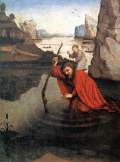Witz’s St. Christopher is a marvellous, dreamy canvas, as though the giant and the child float down the river of the unconscious. Concentric ripples tinged with red, green and white work their way out from the giant crossing the river running through a rocky landscape: the ripples bring perspective to the foreground and diffuse the light in haloes round the central iconic figures. The almost broken staff of the giant, signalling the unearthly weight of the Christ-child, parallels the line of the rock face and indicates the vanishing point. Staff, giant and child are triangulated in the centre of the canvas. Further up the imaginary river, the light is pale, more ethereal, a silvery blue crossed by silhouetted ferries and ferrymen. On the left bank a red-tiled church and cloister with a monk on the shore carrying an osier basket, just like Friar Lawrence in Romeo and Juliet: there’s a secondary triangular relationship between the hooded monk, similar size to the Christ child, and the red-cloaked giant: the child is father to the man, the giant’s strength is tested by the god-child, the monk is their extension in time. The bottom of the picture is all mud and reeds: deep umber river water. A ghostly reflection of the church is as yet undisturbed. Across the pellucid sky three birds – cranes? storks? – echo the triad beneath: monk, giant, child.




One thought on “Konrad Witz 1400-1445”